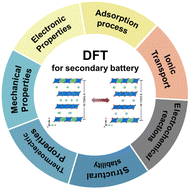Basic guidelines of first-principles calculations for suitable selection of electrochemical Li storage materials: a review
Abstract
In this work, practical ways of using first-principles and machine learning calculations in rechargeable Li batteries to understand the associated electrochemical Li storage reactions as well as support researchers in identifying the suitable electrode and electrolyte materials are described. We summarize in detail the theoretical approaches for different components of lithium-ion batteries (LIBs) in the simplest possible way by categorizing them into two sections: the first section describes the computational approaches for battery investigations, such as structural (DFT and AIMD-based), electronic, thermoelectric, mechanical, adsorption, ion transport, electrochemical properties, and machine learning (ML) over DFT while the second section discusses the use of these computational approaches to investigate the experimental studies on LIBs. This review will be useful to both experimental and theoretical researchers in understanding the electrochemical Li-ion storage mechanism and enable time- and cost-effective fabrication of LIBs with an emphasis on significantly increasing the energy density, lifetime, and safety.

- This article is part of the themed collection: Journal of Materials Chemistry A Recent Review Articles


 Please wait while we load your content...
Please wait while we load your content...